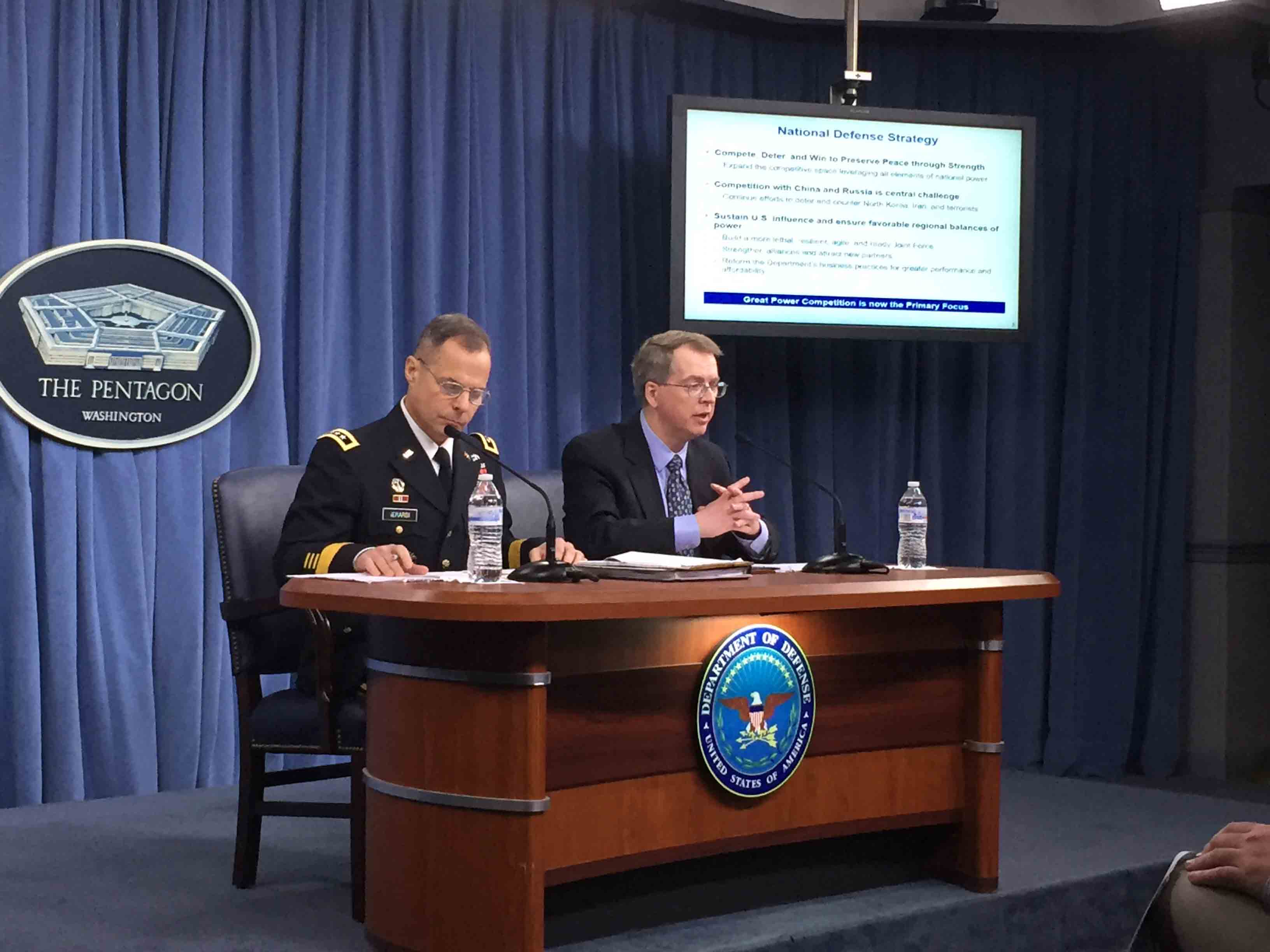Army Lt. Gen. Anthony Ierardi, the Joint Staff's director of force structure, resources and assessment, and DOD Comptroller David Norquist presented the president's fiscal 2019 defense budget request at the Pentagon, Feb. 12, 2018. DOD photo by Jim Garamone
The Pentagon is requesting a total of $686.1 billion in Fiscal 2019, a $74 billion increase from current funding levels. The additional funds will be used for high-end research and procurement to address the potential great power competition with Russia and China, along with an increase in endstrength and funding for the current wars in the Middle East.
The Fiscal 2019 budget request, released Monday, marks a 10 percent growth from current continuing resolution levels. The overall breakdown includes $617 billion in base funding for the services and DOD-wide procurement and research, and $69 billion for overseas contingency operations. If enacted as proposed, the budget would account for 3.1 percent of total gross domestic product.
Over a five-year span beginning in Fiscal 2011, the Defense Department has lost about $400 billion in readiness due to significant reductions in endstrength, aircraft fleets, and operations and maintenance. To claw out of this hole, the Pentagon is now calling for 25,900 more service members and a large increase in weapons buys to replace those used in the war against ISIS and in Afghanistan, Pentagon comptroller David Norquist said during a Monday briefing.
“It is a sign of how deep the hole is that we are in, that it takes this big of an increase just to get the department’s budget back to where inflation alone would have put us,” Norquist said.

In FY19, DOD seeks a 10-percent increase in funding over current continuing resolution allocations. Budget document
The Fiscal 2019 budget request follows the President’s National Security Strategy and the Pentagon’s National Defense Strategy, which both called for an increased focus on potential threats from near-peer adversaries such as Russia and China. This potential threat is reflected in an increase in funding for both research and procurement.
The budget proposal calls for a $17.7 billion increase in total research, development, test, and evaluation, for a total of $92.3 billion in 2019. The Air Force has the largest share of this funding in its base budget, with $39.89 billion in USAF-specific research up from $27.5 billion in 2018. Investments are focused on “critical areas” such as hypersonics, autonomy, integrated air defenses, space resilience, and high-energy lasers, Norquist said.
Procurement is also seeing a jump Defense Department wide, with the total allotment of $144.3 billion, up $18.7 billion from the previous year. Major investments include 77 F-35s, 15 KC-46s, five Evolved Expendable Launch Vehicles, the first large purchase of Combat Rescue Helicopters, and early steps in other programs such as the first two developmental airframes for the Presidential Aircraft Replacement program. The Navy also would see a buildup, with two more Virginia-class submarines, three more DDG-51 Arleigh Burke-class destroyers, and another littoral combat ship. Ground system procurement includes 5,113 Joint Light Tactical Vehicles and 135 more M-1 Abrams tanks for the Army.
The budget calls for a large increase in the weapons most used in the ongoing fight, especially Joint Direct Attack Munitions, Small Diameter Bombs, and Hellfire missiles. The Pentagon is requesting $1.2 billion for 43,594 JDAMs, up from 34,529 requested in 2018. The Navy and Air Force are doubling the number of Small Diameter Bomb IIs requested, a total of 1,260 this year, along with 7,045 more Hellfires.
Of the $69 billion in OCO funding, the Pentagon expects to spend $48.9 billion for the war in Afghanistan in 2019, a $1.8 billion increase from the 2018 request as the military has sent more ground forces and aircraft to contribute to the fight. While US Central Command has said the fight in Afghanistan is its main focus, the Pentagon has increased its budget request for Operation Inherent Resolve, calling for $15.3 billion. That number is a $2.3 billion increase from the 2018 request, and includes additional funding for training for Iraqi border security and Syrian defense forces.
The biggest OCO funding increase, by percentage, is for the Pentagon’s growing presence in Eastern Europe. The European Deterrence Initiative has a requested budget of $6.5 billion in 2019, up from $4.8 billion in 2018. The majority of this funding goes for preplacement of US Army materiel, but also includes USAF projects such as flight line improvements at bases in Germany, Norway, Slovakia, and the United Kingdom.
This year’s budget proposal, unlike others in recent memory, does not address the excess infrastructure back home. The request does not call for a new round of Base Realignment and Closure, instead the Pentagon decided to wait until it finishes its audit and looks to work with Congress to find “common areas” for reform, Norquist said.
The bipartisan budget deal signed last week provided the framework for the Pentagon’s growing coffers. While lawmakers are bound to have issues with many Defense Department proposals, Norquist said he expects lawmakers to be “consistent” with the Pentagon proposal.

